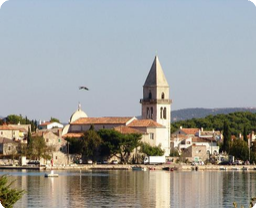

Osor/island of Cres
Osor/island of Cres  Legends of Osor
Legends of Osor
THE LEGEND OF JASON
King Aeetes of Colchis had a golden fleece from a heavenly sheep, which was guarded by a dragon. As prophesised, Prince Jason took a crew of brave young men on the Argo to take the fleece. Helped by wisdom and the spells of Medea, the King’s daughter, who was in love with him, he managed to get hold of the golden fleece and escape by ship with the Argonauts. Apsyrt, the King’s son, followed and caught up with them at the isthmus of Osor. Here, he was tricked and cut into pieces. His body parts turned into the islands of Cres (Krepsa, Crexi) and Lošinj (Apsyrtides) and the 36 islands, islets and reefs of the archipelago. To honour Apsyrt, the islands are called the Apsyrtides. Apsaras (the essence of water) are heavenly dancers born from splashing sea water. The narrow Osor passage, the place where waves from Kvarner and the middle of the Adriatic meet, was reached by Odysseus himself. The origin of these islands has been dated to 25,000 BC.
ST. GAUDENTIUS, THE PATRON SAINT OF THE TOWN AND ISLANDThe Diocese of Osor was founded in 530 and abolished in 1815. St. Gaudentius (Gaudentius Auxerensis) was born in Tržić, a village near Osor that is now abandoned. He worked in Osor from 1018 till 1042 (or 1044 according to some sources). He played an important role in cultural and national revival. He commissioned the building of St. Peter's monastery and St. Mary of Mercy’s convent. Osor became a strong glagolitic centre, which was not favoured by certain members of the Osor nobility who took their chance during a time of Papal instability to strike at him. Bishop Gaudentius had to seek shelter in a dark cave on Mountain Osorščica, where he spent a year as an outcast. The cave was full of snakes, but he did his penance and used God's mercy to rid the islands of poisonous snakes. He escaped to Rome and lived an ascetic life in a Franciscan monastery in Jakin, where he died in a state of grace on 31 May 1044.
After nearly a hundred years, his earthly remains were returned in a miraculous way. All the bells rang out by themselves before dawn. Beneath the town walls, there was a wooden chest floating in the sea (the remains of this chest are kept in the sacral treasury). Inside, there was a metal casket with the remains of St. Gaudentius. The inhabitants of Osor built a small church in his honour and proclaimed him the patron of the town and island.
Source: www.jazon.hr
Video
Current news
 Macrocruise charter agency
Additional discount on the boat rental price of betw
Macrocruise charter agency
Additional discount on the boat rental price of betw




























